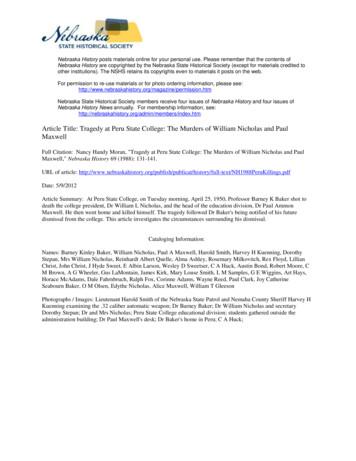
Transcription
Nebraska History posts materials online for your personal use. Please remember that the contents ofNebraska History are copyrighted by the Nebraska State Historical Society (except for materials credited toother institutions). The NSHS retains its copyrights even to materials it posts on the web.For permission to re-use materials or for photo ordering information, please sion.htmNebraska State Historical Society members receive four issues of Nebraska History and four issues ofNebraska History News annually. For membership information, .htmArticle Title: Tragedy at Peru State College: The Murders of William Nicholas and PaulMaxwellFull Citation: Nancy Handy Moran, "Tragedy at Peru State College: The Murders of William Nicholas and PaulMaxwell," Nebraska History 69 (1988): 131-141.URL of article: story/full-text/NH1988PeruKillings.pdfDate: 5/9/2012Article Summary: At Peru State College, on Tuesday morning, April 25, 1950, Professor Barney K Baker shot todeath the college president, Dr William L Nicholas, and the head of the education division, Dr Paul AmmonMaxwell. He then went home and killed himself. The tragedy followed Dr Baker's being notified of his futuredismissal from the college. This article investigates the circumstances surrounding his dismissal.Cataloging Information:Names: Barney Kinley Baker, William Nicholas, Paul A Maxwell, Harold Smith, Harvey H Kuenning, DorothyStepan, Mrs William Nicholas, Reinhardt Albert Quelle, Alma Ashley, Rosemary Milkovitch, Rex Floyd, LillianChrist, John Christ, J Hyde Sweet, E Albin Larson, Wesley D Sweetser, C A Huck, Austin Bond, Robert Moore, CM Brown, A G Wheeler, Gus LaMontain, James Kirk, Mary Louse Smith, L M Samples, G E Wiggins, Art Hays,Horace McAdams, Dale Fahrnbruch, Ralph Fox, Corinne Adams, Wayne Reed, Paul Clark, Joy CatherineSeabourn Baker, O M Olsen, Edythe Nicholas, Alice Maxwell, William T GleesonPhotographs / Images: Lieutenant Harold Smith of the Nebraska State Patrol and Nemaha County Sheriff Harvey HKuenning examining the .32 caliber automatic weapon; Dr Barney Baker; Dr William Nicholas and secretaryDorothy Stepan; Dr and Mrs Nicholas; Peru State College educational division; students gathered outside theadministration building; Dr Paul Maxwell's desk; Dr Baker's home in Peru; C A Huck;
TRAGEDY AT PERU STATE COLLEGETHE MURDERS OF WILLIAM NICHOLASAND PAUL MAXWELLBy Nancy Handy MoranNestled in a belt of hills along theMissouri River in southeastern Ne braska, the state teachers college atPeru is known as "The Campus of aThousand Oaks." By 1950 a village of1,000 people surrounded the oldestcollege in the state, founded as aprivate school in 1867. A seven member board governed Peru (enroll ment 387) along with other stateteachers colleges at Chadron, Wayne,and Kearney.! The colleges trainedstudents to be teachers or adminis trators in elementary and secondaryschools.On Tuesday morning, April 25, 1950,Professor Barney K. Baker taught hispsychology class as usual. No one ques tioned him for giving assignments forthe next three weeks or for remarkingto some students that on this day theywould "have a half holiday."2 Duringhis free period, which began at 11:00a.m., Dr. Baker walked into the officesof the college president, Dr. WilliamNicholas, and the head ofthe educationdivision, Dr. Paul Maxwell, and shot bothmen to death. He then went home andkilled himself. Classes were dismissedfor the afternoon in a "half holiday" ofthe gravest nature.The incident shocked and bewilNancy Handy Moran ofAuburn is a regis tered nurse. In 1987 she received theFrederick Adrian Award given by theUniversity of Nebraska at Omaha forundergraduate historical research.dered people in the college and thetown. Long after reporters and policehad left Peru, many questionsremained. People in the communitystill talk about the events of April 25.Baker's suicide made impossible acomplete investigation of his motive forthe murders. However, the evidenceindicates that the crimes were directlyrelated to Baker's dismissal from thePeru faculty where he had taught fortwenty-four years.In 1926 thirty-year-old BarneyKinley Baker came to Peru TeachersLieutenant Harold Smith (left) of the Nebraska State Patrol and Nemaha CountySheriff Harvey H. Kuenning examine the .32 caliber automatic found with Dr. BarneyBaker's body at his Peru home. Baker committed suicide after shooting Dr. WilliamNicholas, Peru State College president, and Dr. Paul Maxwell, head of the collegeeducational division. Courtesy of Lincoln Journal-Star.
Nebraska History - Fall 1988College as a part-time associate pro fessor of science and education. Beforejoining the Peru faculty, he had servedas principal and superintendent ofsecondary schools in Missouri,Oklahoma, and Kansas, and as assis tant professor of education at KansasState Teachers College at Pittsburgfrom 1922 to 1924. 3 Baker took a leaveof absence from teaching to earn hisdoctorate at the University of Kansas,becoming a full professor of psychologyat Peru in 1933.4 In 1949 Baker learnedof his pending dismissal from thePeru faculty.The two men responsible for Baker'splanned dismissal were Dr. PaulAmmon Maxwell, Baker's superior ashead of the division of education since1929, and Dr. William L. Nicholas,president. Dr. Maxwell, fifty-three, hadtaught high school math and science inthe east before coming to Peru. 5 Amember of many professional and com munity organizations, he had written abook and several articles about educa tion. 6 Dr. Nicholas, forty-eight, wasborn in a sod house at Mason City, Cus ter County, Nebraska. He had servedas a principal and superintendent atschools in Tryon, Nebraska, and atOshkosh, Wisconsin; as dean of men atKearney State Teachers College; andas Director of Occupational Informa tion and Guidance in the NebraskaDepartment of Vocational Education.He was elected to the presidency ofPeru State Teachers College in 1946.7When Nicholas came to Peru hewanted to revitalize the college; rumorswere circulating that the state wishedto close the school. Both the physicalplant and morale had deteriorated. 8 InMay 1949 Nicholas informed divisionheads that classes should be combinedto require a smaller faculty and toeliminate classes with only a fewstudents. 9 He requested that divisionheads recommend which teachersshould be retained. 10 On May 19, 1949,Dr. Maxwell wrote to Nicholas report ing that some elective and low enrollment courses were beingdropped from the education division,Dr. Barney Baker. Courtesy of OmahaWorld-Herald.thereby making it possible to cut oneprofessor's position from the nine pre viously required. The position recom mended for elimination was the oneoccupied by Dr. Barney Baker.llOn June 23 Maxwell and Nicholasmet with Baker to discuss the pos sibility of his dismissal, mentioningthat he was the only professor in hisdivision who did not have duties otherthan teaching,12 Baker, however, hadthe only Ph.D. in the education divisionbesides Maxwell and had seniority overthree other professors who had beenhired by Nicholas after 1946.13 Bakersurprisingly earned a salary of only 3,540 annually, less than any otherholder of the Ph.D. on campus and lessthan many of the college's teacherswith master's degrees (Peru employedthirty-seven professors).14 He usuallytaught fifteen hours each semester,while other professors averaged fromseventeen to twenty-six hours of course132work. Baker served on a single commit tee, while other faculty membersgenerally participated in three or morecommittees or group sponsorships.15Baker reportedly took little part incampus activities and often resistedaccepting new class assignments orextra-curricular duties such as timingat sports events. 16Some students reported that Bakerdid not update his notes and that manyof them were faded and yellowed withage.'7 But one student, Lillian Christ,the wife of Peru professor John Christ,told her husband that Baker was abrilliant teacher. Professor Christrecalled her comment in a statement hesigned after the murders.18 After 1948Baker allegedly became uncooperativeat meetings of the education division,remaining silent or giving only negativecomments, behavior that apparentlyirritated Dr. Maxwel1. 19Though Baker perhaps seemed lessproductive than other Peru facultymembers, long-term professors at thecollege had not been dismissed withoutserious reasons, reasons which inBaker's case were never revealed. 20Baker's personnel file contained onlytranscripts, tax and salary records, andteaching assignments; there was noth ing referring to his dismissal,21Following the murders, there wasspeculation about why Baker wasasked to leave. Nemaha County Attor ney Fred C. Kiechel called it part of areorganization program at the college. 22The Omaha Morning World-Heraldquoted the president of the Board ofEducation of State Normal Schools, J.Hyde Sweet, as saying Baker had been"unable to hold the attention of hisclasses."23 In his own "Kick Kolumn" ofthe Nebraska City News-Press, thenewspaper he edited, Sweet stated that"there were good and sufficientreasons for the decision which hadbeen mulled over for a long time. It isnot necessary to go into their details,except to say that the integrity of theschool, any school, depends on givingstudents the very best service . . . thefacts deny that any injustice had been
Tragedy at Peru State Collegedone [to Baker] ."24 There wereunsubstantiated rumors that Bakerhad committed some sexual impro priety, although they may havestemmed from the fact thathe includedinformation about sexuality in some ofhis psychology classes.President Nicholas had a reputationfor tact and skill in handling people.When he assumed the presidency ofthe college, he had given retiring presi dent W. R. Pate an office on campus asa courtesy. Known for his benevolentnature, Nicholas had proved adept atresolving the concerns of former ser vice men who had entered college ongovernment loans or grants after WorldWar II. Students often came toNicholas's home or office for coun seling.25At the June 23, 1949, conference,Nicholas and Maxwell advised Baker tosecure another position, telling himthat they would take no dismissalaction immediately, but that they didnot plan to employ him after the sum mer of 1950. 26 Nicholas offered to assistBaker in finding another job and laterexpressed concern to his secretary,Dorothy Stepan, that Baker had neverasked him for a letter of recommenda tion or other help.27 Although CountyAttorney Kiechel declared that severalconferences were held to considerBaker's reinstatement, Stepan recalledno such meetings.28 Because Nicholasand Maxwell kept the dismissal con fidential, only a few faculty membersknew of it, and they were sworn to se crecy unless Baker himself chose toreveal it. 29There was considerable ambiguity inNebraska law in the 1950s regardingthe status of faculty at the stateteachers colleges. The statutesempowered the Board of Education ofState Normal Schools to appoint orremove the president, faculty, andother employees of the colleges. Thepresidents were authorized to manageand control college employees, but thestatutes were not specific about thepresidents' power to appoint or dismissthem. 30 Customarily the presidentmade personnel recommendations tothe board and had them acceptedwithout question.31The board maintained in aworkmen's compensation case afterthe murders that no vote by the bodywas needed to terminate a teacher atthe end of any academic or calendaryear, because it judged teaching jobs tobe one-year, renewable appointmentsof public officials. 32 A 1923 court caseinvolving the dismissal of the head ofthe Peru English department hadresulted in a Nebraska Supreme Courtdecision that a teacher was consideredan employee rather than a public offi cial. 33 Although state statutes men tioned no protection such as tenure, thecollege at Peru may have had an infor mal tenure policy.34 However, formalemployee grievance procedures didnot exist.In October 1949 Baker asked BoardPresident J. Hyde Sweet to intercedeon his behalf in light of Baker's twenty four years of teaching at Peru. 35Apparently Sweet never brought thematter before the board. E. Albin Lar son, secretary to the board, told re porters investigating the murders thatNicholas had authority as president torelease a staff member in arrangingteaching assignments for the comingyear. Then, said Larson, the boardwould take formal action on the releaseat a later date. But Larson noted thathis office had received no notificationof Baker's dismissal. 36 The officialminutes of the board from May 1949 toApril 1950 show only one recommenda tion for the termination of an employeeat Peru, a campus gardener. In that casethe board endorsed Nicholas's recom mendation that the employee be ter minated on a specified date. 37 Theminutes included no reference to thedismissal of Dr. Baker.One other professor at Peru, WesleyDr. William Nicholas, Peru State College president, and secretary Dorothy Stepan.Courtesy of James D. Levitt.133
Nebraska History - Fall 1988D. Sweetser, M.A., was released in 1950and replaced by a professor who heldthe Ph.D. This dismissal was public,acceptable to Sweetser, but also notrecorded in the official minutes of thecollege board. Sweetser's nameappeared for the last time in the sum mer 1950 college directory.38Although Baker's chances of findinga new job were limited by his age andthe fact of his dismissal from a long time position, he sent out many jobapplications to schools in Oklahomaand Kansas during the autumn andwinter of 1949-50. 39 When he receivedonly rejections, he apparently becamedeeply discouraged though he had nottaken advantage of the president'soffer to help him relocate. 4oSome people considered Baker sul len and aloof because he seldom spoketo people on campus and had few closefriends. 41 His neighbor, ProfessorWesley Sweetser, walked back andforth to school with him. When Sweet ser mentioned that he was beingreplaced by a Ph.D., Baker respondedthat Sweetser was lucky to leave whileyoung, because he could find anotherjob easily. Baker never mentioned hisown dismissal to Sweetser; Sweetserdid not know of it until the morning ofthe murders. In a statement signed thatafternoon, Sweetser described Bakeras a "taciturn individual."42 Baker'sbusiness agent, C. A. Huck, later re ported that Baker "was insanelyjealous of his job and felt he wasn'tgiven credit for his ability."43Professor John Christ once heardBaker make some bitter remarks aboutthe administration. Christ and anotherprofessor, Austin Bond, met Baker in agrocery store in nearby Auburn. WhenChrist mentioned the dismissal ofSweetser, Baker remarked that Sweet ser was young enough to get a new job,but "an old fud like you and I could notdo that. That is typical of Dr. Nich olas."44Dr. and Mrs. Nicholas. Courtesy of James D. Levitt.Like most of the faculty, Christ andBond knew nothing of Baker's dis missal until the new college catalogcame out on the evening of April 24,1950. 45 The catalog was widely cir culated on campus the following morn ing. Barney Baker's name, usually atthe top of the alphabetical list of pro fessors, was absent. The dismissal waspublic, final, and three months earlierthan the deadline Nicholas had ori ginally mentioned. 46On the morning of Tuesday, April 25,1950, Baker, a bird watcher, wrote in hisdiary, "Today I saw my first Jennywren."47 For others, a flooding MissouriRiver was the main topic of conversa tion on campus. 48Tuesday was the dayfor the weekly policy committee meet ing in the administration building. Thiswas the most powerful committee atthe college, responsible for policy,budget, and curriculum within boardguidelines. Its members were the presi dent, the deans of men and women, RexFloyd of special services, and the divi sion heads: Paul Maxwell, education;Robert Moore, language; A. V. Larson,practical arts; A. G. Wheeler, physicaleducation; Austin Bond, math andscience; and C. M. Brown, socialscience. 49 On this particular Tuesdaythe committee lacked a quorum anddid not meet for the first time in nearlya year. One member, Bond, had suf fered a mild heart attack; Floyd hadtaken the college choir to Falls City.Baker reportedly looked into the com mittee room that morning, thenstopped nearby at the mail room, ask ing an employee, "Have you seen any ofthe president's white haired [sic]boys?"50 This comment led to specula tion later that Baker wanted to addressthe meeting or possibly to harm themembers of the committee.In the president's office, secretaryDorothy Stepan responded to Pro fessor Christ's comment that Baker'sname had inadvertently been left out ofthe college catalog. "It's nota mistake,"she told him.51Shortly after 11:00 a.m., Stepan tooksome papers into the president's office
The Peru State College educationaL division at the time ofthe murders consisted ofReinhardt ALbert Quelle (left), Dr. PauLA. Maxwell,Dr. Barney K. Baker, ALma AshLey, Rosemary MiLkovitch, and Rex FLoyd. Courtesy of James D. Levitt.and asked him ifhe had time to see GusLaMontain and James Kirk of the KirkTypewriter Company of Omaha.52Meanwhile, the two salesmen visitedwith Professor Baker in the outeroffice. Baker, who appeared calm,asked them about a trade-in price onhis portable typewriterY They werenot aware that Baker carried a .32 Coltsemi-automatic pistol under hiscoat. 54The secretary returned to her deskand motioned the salesmen to enter Dr.Nicholas's office. But Baker protestedthat he had been there first and saidthat his business would take only aminute. When Stepan told the presi dent that Baker wished to see him,Nicholas nodded his approval. 55Dr. Baker went into the office, closedthe door as was usual when discussingconfidential matters, then drew hisgun. He fired at Dr. Nicholas from closerange, striking him twice in the headand twice in the chest. Nicholas diedleaning back in his chair with his headresting against the radiator. 56 Althoughthe salesmen and secretary heard fiveexplosions and a sound LaMontainlater described as someone falling overa chair, they thought the sounds werefrom construction work going on inthe building.As Baker emerged from the inneroffice, all three saw the gun half-hiddenunder his coat. 57 He faced Stepan andkept the gun trained on her while hebacked out into the hallway. ThoughStepan hoped the salesmen mightoverpower Baker, they followed himout the door and disappeared. OnceBaker had gone, Stepan rushed intoNicholas's office to find the president'sbody sliding down in the chair. Sheshouted for help, then phoned the doc tor, police, and the superintendent ofthe elementary school on the campus towarn him to keep the childreninside. 58Meanwhile, Baker walked deliber ately the few steps to Maxwell's officedownstairs, passing Wesley Sweetserand John Christ on the way.59 To avoidMaxwell's secretary, Mary LouiseSmith, Baker entered the office by aside door. Smith looked up from herwork to see Baker's gun near Maxwell'shead and heard three shots, one ofwhich struck Maxwell with fataleffect. 60 Maxwell had a habit of not135looking up from his reading unlessaddressed. 61 He never saw Dr. Baker.While Smith ran screaming from theoffice, Baker walked across the hall tohis own office, where he put the gun'sempty magazine on his desk and pickedup his hat and coat.62 On his way out heagain passed Sweetser and Christ, whohad started downstairs after hearingthe secretary's cries. When Sweetsersaw the gun, he ran back to the hall andducked into the personnel office "justin case he [Baker] was runningamuck."63 From a window, Sweetserwatched Baker walk towards his white,two-story house at the edge of the cam pus. Professor Baker had once told hispsychology students that during a sud den catastrophe, most people respondineffectually. His theory proved cor rect for no one tried to stop him oncethe killing began. 64Professor Sweetser and buildingsuperintendent L. M. Samples werethe first to check Maxwell, finding nopulse. Dr. G. E. Wiggins, college physi cian, arrived within ten minutes of theshootings and pronounced both mendead about 11:40 a.m.65 Samples, aclose friend of Mrs. Nicholas, went to
Nebraska History - Fall 1988Students gathered outside the administration building after news ofthe murders spreadto await details and instructions. This picture was taken from a window in the office ofthe college's slain president. Courtesy of Lincoln Journal-Star. (below) Dr. Paul Max well was seated at his desk when shot by Dr. Baker, whose office is across the hall. Cour tesy of Omaha World-Herald.her home to tell her what had hap pened. 66Many studentsjoined the crowd nearthe administration building, whilethose more timid or sensible locked thedoors to their dormitory rooms andwatched the activity from the windows.Others foolishly rushed to Baker'shouse. In a survey done after thekillings, most students expressed acommon theme about their actions: "Ifollowed the crowd around." One stu dent, a veteran, grabbed his gun andheaded for the elementary school toprotect his children. Rumors spread:Baker had wounded some children: hewas hiding in the hills; he wasbarricaded in his house; he had tried tokill other teachers, especially membersof the policy committee.67City Marshal Art Hays and localpoliceman Horace McAdams had setup a guard by Baker's house. When twohighway patrol cars and County Attor ney Kiechel arrived shortly after noon,the men walked to the front door, towhich was pinned an envelope with amessage: "Mr. Huck, Walk in and takeover." "Then," said Kiechel, "I knew hehad committed suicide."68 Baker'sbody was found on a Persian rug, asuicide note and pen several feet away,and the gun where he had dropped itafter shooting himself in the mouth. 69Rex Floyd, who had taken the collegechoir to Falls City that morning, was acaptain in the army reserve and arecent college graduate with a master'sdegree. As director of special services,he did public relations and student re cruitment, directed off-campus studiesand activities, and assisted PresidentNicholas. Having known of Baker'spending dismissal since 1949, he oncewarned the president not to see Bakeralone, fearing that Baker might becomeverbally abusive. He never suspected,however, that Baker might becomeviolent,7 Near noon on his way back to thecollege, Floyd heard KFAB radio ofOmaha announcing shootings at thecampus. At Peru, after verifying thekillings, Floyd hurried to Baker's house
Tragedy at Peru State Collegewhere male students, many of themwith guns, had converged. Floyd as sisted the sheriff in getting thestudents to disarm. After Baker's bodywas found, he returned to the adminis tration building and set up a commandpost to handle inquiries from the pressand assist law enforcement officials.71Floyd met with Dean ReinhardtQuelle, the ranking administrator oncampus. While secretary Stepan begantaking witnesses' statements, Floydhad local operators transfer all calls tothe switchboard in the administrationbuilding.72 Despite his efforts the Lin coln Evening Journal was unable to getthrough by telephone and flew policereporter Dale Fahrnbruch andphotographer Ralph Fox to the Peruarea. 73 For forty-eight hours Floydanswered media calls from the sur rounding states. During the night hetook calls at home from correspon dents representing newspapers in Lon don, Paris, and Tokyo.74On Wednesday morning the follow up calls began: What were Baker'smotives? When are the funerals? Whowill become president? Floyd handledaffairs with finesse, drawing praisefrom reporter Fahrnbruch, who wroteFloyd that "it is seldom that we receivethe type of cooperation that you gave usin covering stories of this type."75The media attention upset theresidents of Peru. Corinne Adamswrote in her "West Side Items" columnofthe Peru Pointer: "One ofthe hardestparts [of the weekI was the way thereporters and newscasters handled theaffair, having a field day. Theirmethods seem[edl harsh and their pro duct sensational."76J. Hyde Sweet, president of theBoard of Education of State NormalSchools, arrived on campus the after noon of the murders to name DeanReinhardt Quelle acting president.Dean Quelle decided to resume classesWednesday morning, hoping theroutine would calm the students. Hereassigned other professors to teachBaker's and Maxwell's classes. Socialactivities were postponed until afterthe funerals. 77 Quelle coordinated amemorial convocation on campusThursday morning for the two slainmen. Although the administration andState Superintendent of PublicInstruction Wayne Reed initiated plansto honor Nicholas and Maxwell by mak ing April 25 an annual date for campusobservances honoring the two educa tors, the plans were soon forgotten.The college administration had nodesire to perpetuate memories of theviolence. 78 Nicholas was honored dur ing the college's centennial convoca tion in 1967.On Friday, April 28, the church choirMaxwell had directed sang for hisfuneral at the Peru MethodistChurch.19 The next day the board ofeducation met in special session on thecampus. It voted to have ReinhardtQuelle continue as acting presidentand thanked state superintendentWayne Reed for assisting Quelle. (OnJune 17 the board unanimously electedReed to the presidency of PeruTeachers College).The board also heard investigativereports from Wayne Reed, J. HydeSweet, and County Attorney Kiechel,although no minutes were recorded.The board sent resolutions to Mrs.Nicholas and Mrs. Maxwell recognizingtheir husbands' service and sent a let ter of condolence to Baker's widow. At4:00 p.m. the board adjourned to thecrowded First Christian Church in Perufor Nicholas's funeral. 8oIn the hours following Baker'ssuicide, police established the pre meditation of his deed. He had madeelaborate plans. The day before themurders Baker had endorsed threechecks and had written one for thebalance of his checking account. In thesteel box with the checks he hadclipped a note to an insurance policy,"still good."81 He had labeled his keysand had executed an informal bill ofsale transferring ownership of his 1937Chevrolet to his wife. 82 Although Bakerhad not made out a will, perhaps herealized that a court might overrule it,viewing his suicide as evidence of men 137tal illness.83 Baker had typed hissuicide note on an old portable type writer in his office. He had addressed itto C. A. Huck, a professor in the physi cal science division, who acted asBaker's business agent.84 The note wasnever disclosed in full to the media, buta copy was later placed in the collegearchives:Mr. Huck,Please take charge. Use Casey of Auburn asdirector. Services about 400.00. Cremate andscatter ashes at night on the south side of the roadabout eight (8) telephone poles east of the Perucorner. Let only one person know what youhave done.Funeral services at chapel with Presbyterian pro cedure. No relative lsI are to be notified exceptJoy who is at 910 Lidsay [sic] Street, OklahomaCity, Oklahoma, or Grove, Oklahoma.Stay in my house at night or get someone to untilthings quiet down. P. C. might try to cause trou ble. You are to be paid for your services.P.S. Take charge of my office and !:Iring every thing down to the house.[signed] B. K. Baker[handwritten in ink] Willie tried to fire thewrong person.8SInitially County Attorney Kiechelassumed "P. C." to be Paul Maxwell'sfirst and middle initials and thoughtBaker might not have planned to killMaxwell when he had written thenote. 86 Since Maxwell's middle initialwas "A.," the note most likely referredto Maxwell's adopted son, Paul Clark,who was commonly called "P. C."87About twenty at the time and noted forhis hot temper, Paul was married andhad an infant son. When he heard aboutthe murders, the younger Maxwellwent to Baker's house with a gun andjoined the crowd there. 88 The inves tigators decided that "Willie" in thenote referred to president WilliamNicholas.Baker's wife of thirty-three years,Joy Catherine Seabourn Baker, had toface the burden of her husband's deed.A small, red-haired woman, Joy wasproud of her Cherokee Indianheritage. 89 She worked part-time as afreelance writer and sold nonfictionarticles and poetry to magazines underthe name "J. S. Baker."90 Trained as ateacher, she had once applied to teachat the training school in Peru.91On April 25 Mrs. Baker was in
Nebraska History - Fall 1988Dr. Baker's home in Peru. Courtesy of Omaha World-Herald.138
Tragedy at Peru State CollegeOklahoma visiting a sick brother.There she received the news of themurders from her friends, ProfessorRobert Moore and his wife, Bess. TheMoores had sometimes dined with theBakers, and Robert Moore had huntedpheasants with Barney Baker. Moorehad known of Baker's dismissal since1949 but had never mentioned it toBaker. Nor had Moore ever heardBaker criticize anyone at thecollege.92Joy Baker arrived in Peru the dayafter the murders, calm in her outwardappearance. Though surprised by theviolence, she had known of her hus band's deep anger. The Mooresreceived some criticism for helping JoyBaker during this time, but most peo ple were charitable and pitied her.93They regarded Barney Baker as a manwho had lost his mind, rather than as acold-blooded killer. Many people fromthe college and town attended Baker'sfuneral at the funeral home inC.A. Huck, part-time mathematicsinstructor at the college, was Baker'sbusiness agent and the person to whomBaker addressed a note left on his frontdoor. Huck holds the book ModernCriminal Investigation, which wasfound near Baker's body. Courtesy ofLincoln Journal-Star.Auburn. 94 Although Baker had taughtSunday school years earlier at the PeruMethodist Church, he had no activechurch affiliation at the time of hisdeath.95 However, his wishes for a Pres byterian service were carried out. In adisplay of charity toward Baker'swidow, responsibility for the servicewas share
Oklahoma, and Kansas, and as assis tant professor of education at Kansas State Teachers College at Pittsburg from 1922 to 1924.3Baker took a leave of absence from teaching to earn his doctorate at the University of Kansas, becoming a full professor ofpsychology at Peru in 1933.4In 1949 Baker learned of his pending dismissal from the

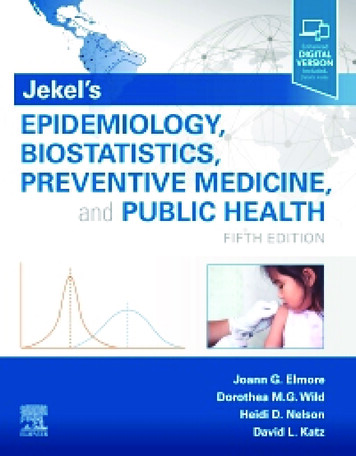

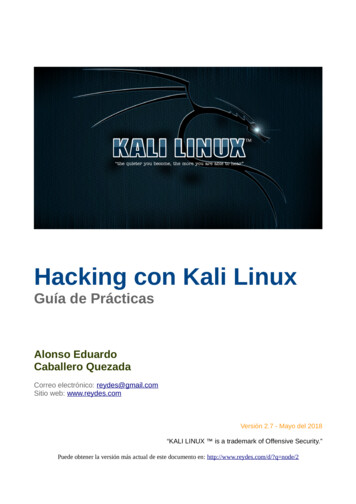

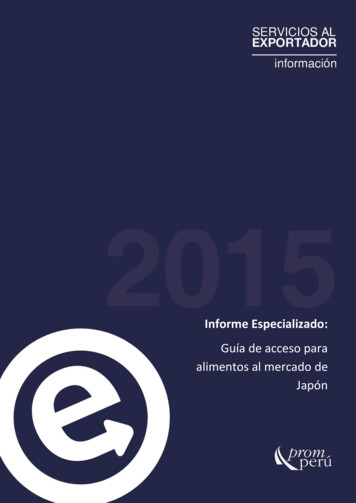

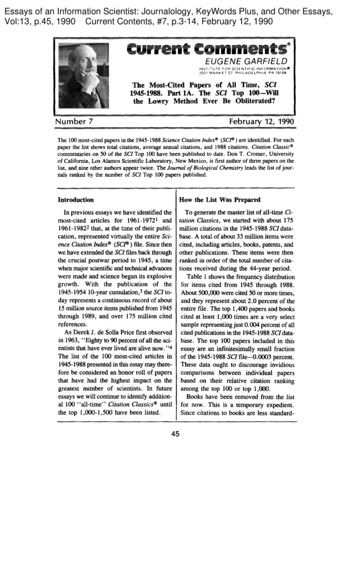

![Index [ sensen-na ]](/img/27/2021-sensen-catalog.jpg)
